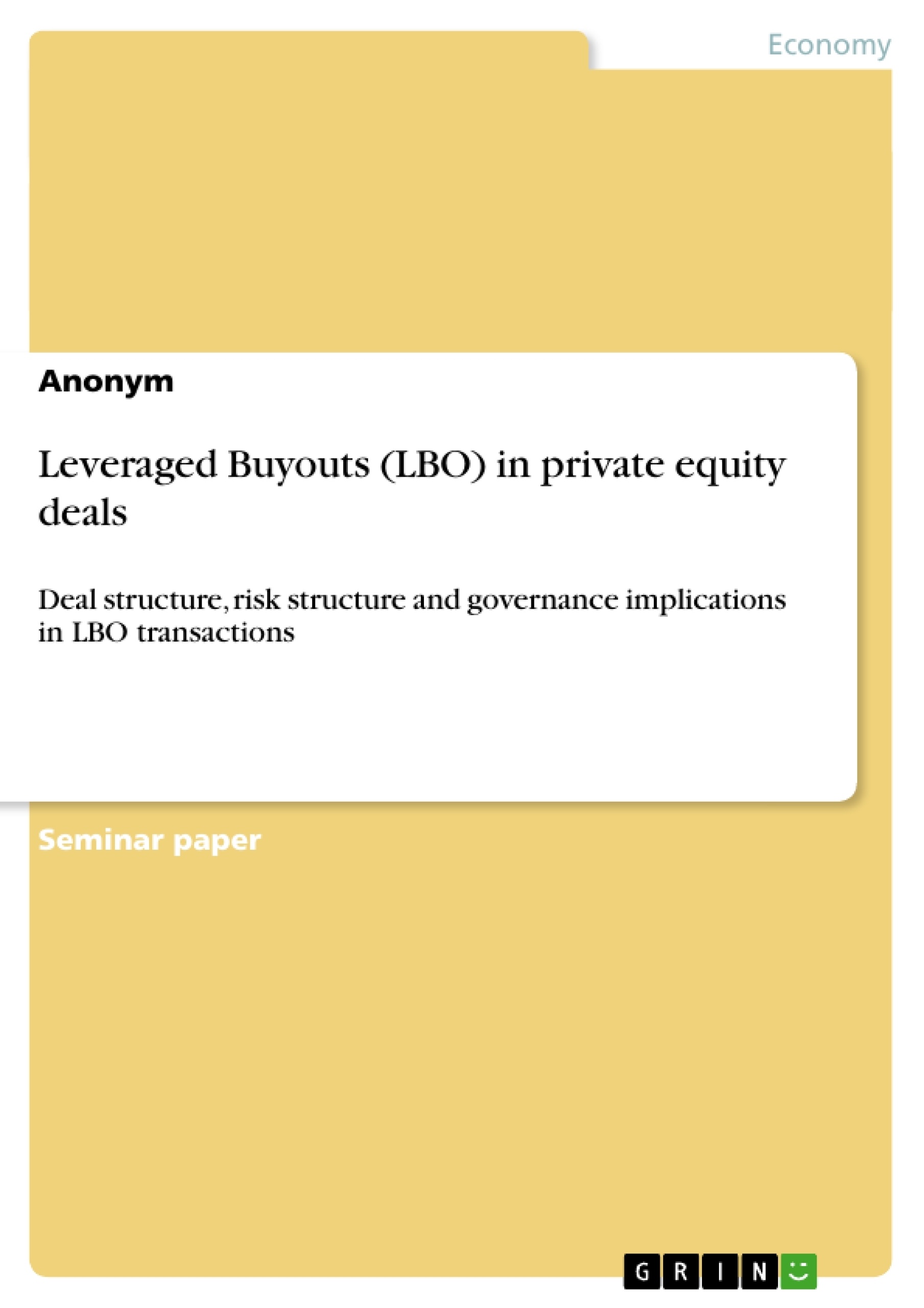Igniting in 2005, the discussion about highly leveraged transactions conducted by financial institutions became a matter of great controversy in German politics as well as in the media. Fuelled by an influential voice in politics, LBO firms became the face of capitalism’s evil by calling them a “Heuschrecke”, an animal much feared in history for its exploitive behaviour and risks to the mediaeval agrarian economy (Die Zeit, 2005). In terms of today’s Heuschrecke, according to public voice, downsizing and raiding
represent the major risks attributed. Empirics show that the risk of downsizing in LBOs is falsified and that the occurrence of raids is rather irrelevant in today’s buyout universe. However, even if both risks held,
each would exhibit a comparably low impact on the economy as a whole. Contrary, the empirically evident high-impact risk of over-indebtedness in leveraged
transactions is widely neglected. The negligence of this risk-issue is dangerous, particularly with regard to the recent developments in the LBO industry, debt capital markets and the world’s economy. First, analysing the latest LBOs conducted, it appears
that the historical failures, such as the buyouts of Revco and RJR Narbisco are widely forgotten, as gearing ratios have become aggressive again. Second, the subprime crisis, which was exported from the US real estate sector into global capital markets, caused
liquidity shortages – AA rated banks were not willing to lend money to their equally rated peers anymore – which led to a credit crisis. This credit crunch provoked that, even though in the US the prime rate has been reduced by 50 bp, and in the Eurozone
the prime rate was not increased as planed, ‘money became expensive’; FIBOR, LIBOR and EURIBOR sharply increased and remained high. This resulted in high debt funding costs. Third, taking a look at the world economy, America might face an economic
downturn in the near future with decreasing consumption and increasing inflation. Each of the three aspects alone increases the default risk in a highly leveraged firm. In a scenario where all three jointly appear, the probability of default sharply increases. In addition to the risk named, the threat an LBO imposes on global debt capital markets is evident, therefore, it can not be ignored any longer in Europe. While it was already heavily discussed in America’s late 80s buyout-boom, it slowly gains prominence in discussions about LBO transactions.
Table of Contents
- Executive Summary
- Course of Investigation
- Definition of an LBO
- How Does an LBO Work
- Deal Flow and Screening Phase
- Financial Criteria
- Business Criteria
- Due Diligence and Acquisition Phase
- Due Diligence
- Acquisition Structure
- Holding Structure
- Financial Structure
- Monitoring and Advising
- Exit
- Deal Flow and Screening Phase
- Risk Management in LBO Transactions
- Credit Implications for the Lending Parties
- Default Risk
- Exposure Risk
- Recovery Risk
- Principal Agent Conflict between Lender and LBO Firm
- Typical Risk Factors to the Target and its Stakeholders
- Operational Risk Caused by Buyout Firm Misbehaviour
- Leverage Risk Implications
- Excursus: Scenario Analysis
- Losses for Previous Bondholders
- Risks to the Financial System
- Credit Implications for the Lending Parties
- Governance Implications in Leveraged Financed Deals
- The American Corporate Governance System
- The Legal Form of a Corporation
- The Securities and Exchange Commission
- The Sarbanes-Oxley Act of 2002
- The German Corporate Governance System
- The Legal Form of the Aktiengesellschaft
- The Development of the German Corporate Governance System
- Creditor Protection in LBO Transactions
- Separation of Power and the Free Cash Flow Hypothesis
- The Validity of the Free Cash Flow Hypothesis
- The American Corporate Governance System
- Conclusion
Objectives and Key Themes
The seminar paper “Leveraged Financing of Private Equity Deals” explores the complex world of leveraged buyouts (LBOs), examining the structure, risks, and governance implications associated with these financial transactions. The paper delves into the historical context of LBOs, analyzing the recent surge in their popularity and the controversies surrounding them.
- Deal Structure and Risk Management in LBO Transactions
- Impact of Leverage on Target Companies and Stakeholders
- Governance Implications of LBOs in Different Legal Systems
- The Role of the Free Cash Flow Hypothesis in Understanding LBO Dynamics
- Potential Risks to the Financial System Posed by Over-Leveraging
Chapter Summaries
The paper commences with an executive summary, highlighting the increasing prominence of LBOs and the associated risks. The subsequent sections delve into the mechanics of an LBO, encompassing aspects such as deal flow, due diligence, acquisition structure, financial structure, and exit strategies.
Chapter 4 delves into risk management in LBO transactions, examining the credit implications for lending parties and the potential risks to target companies and their stakeholders. It scrutinizes the principal-agent conflicts that can arise between lenders and LBO firms, highlighting the inherent risks associated with high leverage.
Chapter 5 explores governance implications in leveraged financed deals, comparing the American and German corporate governance systems and analyzing the mechanisms for creditor protection in LBO transactions. It examines the separation of power principle and evaluates the validity of Jensen's free cash flow hypothesis in the context of LBOs.
Keywords
The paper focuses on key concepts such as leveraged buyouts, deal structure, risk management, governance implications, free cash flow hypothesis, debt financing, private equity, target company, stakeholders, and financial system.
- Quote paper
- Anonym (Author), 2007, Leveraged Buyouts (LBO) in private equity deals, Munich, GRIN Verlag, https://www.grin.com/document/90175




